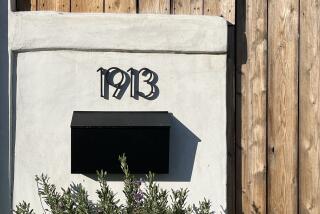Understanding Different Types of Homes
- Share via
There’s a wide selection of homes out there -- which is one is right for you? Depending on how much maintenance you want to do, how much privacy you need, or if you want something custom built to suit your particular tastes, each home type has its own features and benefits. And depending on the different stages of people’s lives -- whether they have children or are retiring -- one type of home can be more attractive than the other.
Single-family homes
These detached homes -- houses that sit on there own lot -- come in one- (ranch), two- and three-level styles. Their exterior appearance can be contemporary, Colonial, Tudor, Victorian or Georgian, for example. As the name implies, single-family homes are ideal for families, especially those with children. Elderly folks who prefer not to climb stairs usually opt for a single-level ranch home. Privacy is an attractive characteristic of these homes, which usually have a fenced back yard. On the other hand, you’ll have to keep up with more maintenance than with other home types.
Condominiums (condos)
Condos are individually owned homes attached to one another in a building (like apartments), and feature common facilities, such as recreation areas and fitness rooms. Each condominium building belongs to an association of all its owners. The association determines the monthly assessment fees and rules and regulations that govern the entire building. The association also decides on maintenance and improvements to the condo building. Like a single-family home, you build equity when you own a condo, but unlike a house, you have less maintenance to deal with. Among the drawbacks of condos is less privacy, and during a housing-market downturn, they usually depreciate more than a house.
Cooperative apartments (co-ops)
Similar to condos but usually less expensive, co-ops are popular in large urban areas. New York City is known for them. A co-op is different from a condo, in that instead of buying the unit, you buy shares in a corporation that owns the building. And before you can buy shares, you have to be approved by the building’s co-op board. Each shareholder has the right to lease a specific unit in the building. Keep in mind that you may have a more difficult time selling your co-op unit because of the board-approval process.
Townhouses
Whether they’re one, two or three stories tall, townhouses (also called townhomes) are typically vertical in design. Some even come with attached garages. They blend the privacy of a single-family home with the benefits of the exterior condo maintenance, which is usually done by the homeowners’ association. Many townhouses are built in what are called planned unit developments (PUD), clustered communities that have areas for residential and commercial use, and public areas such as schools, parks and the like.
Fixer-Uppers
These are usually condos and single-family homes that are in need of extensive repairs, maintenance or updating. Fixer-uppers are usually a good value to buyers who want to put some ‘sweat equity’ into a property and add some personal touches to it. On the other hand, they can also be a financial drain if they have any major defects, such as foundation cracks and defective heating and air conditioning units. Have a professional home inspector check the home from top to bottom before you decide to buy it.
Vacation, or Second Homes
When you just have to get away from it all, a cabin in the woods, an idyllic lakefront property or a golf community in a warm climate all attract owners of vacation homes. Second homes are more difficult to manage, because you don’t live nearby to coordinate maintenance and repairs. You may also rent your vacation home, but consider hiring a local rental-management company if you live far away and won’t be able to handle problems when they arise.
New-Construction Homes
How would you like your home to look? New construction housing allows you to design a home from top to bottom. You can pick your choice of finishes, cabinets and bath fixtures and more. Some builders also allow you to move walls in predesigned models and pick the lot within their community to place your home. Expect to pay more money for a new construction. Preconstruction typically offers you reduced pricing before a development or building gets under way. You need to be fairly creative to visualize your new home from floor plans, because there usually aren’t models to view until the project gets underway. If you decide to purchase new construction, make sure you research the developer or builder’s track record before you sign the purchase contract.
Green Homes
Green, or eco-friendly living, is blooming everywhere in our society today. No less in the world of real estate, where green building and renovation are becoming mainstream. According to the U.S. Green Building Council (USGBC), a green home uses building materials from recycled products, including woods such as bamboo that are quickly renewable. A green home uses less energy, water and other natural resources, and it should generate some of its own energy with photovoltaic cells (solar panels) or wind turbines. Inside, a green home’s windows and doors are well-insulated, and paints, carpets and other materials do not emit volatile organic compounds. A green household also has cost-saving Energy Star lighting and appliances, and showerheads and toilets that use less water. Look for the USGBC’s LEED certification in a green home, which means that it meets sustainable constructions standards.
Many green homes are being built in green communities located on sustainable sites. These communities feature convenient public transportation, nearby health and social services, walkable options for recreation and shopping and accessible bike paths.
More to Read
Sign up for Essential California
The most important California stories and recommendations in your inbox every morning.
You may occasionally receive promotional content from the Los Angeles Times.






